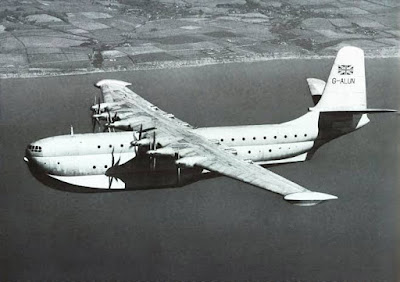It's been a while, I haven't posted anything new. But the topic which I am writing about, is so intriguing that I can say sorry for the delay. Please hold tight as we are going to read something magical.
THE GENESIS OF SEA-PLANES
The WW-II marked the important era of revolution in the manufacturing and development of the new industries, also counting the Airliner industry. But at that time there was a lack of airstrips and airports, which were (at that time) grass and dirt type. This fueled an option of seaplanes.
 |
| Source: Wikipedia |
The starting was normal, some small planes and some with designs on the table. In 1943, one such design was made, which had a formidable space to carry more than 100 passengers and can fly at a good speed of 545 km/h. But due to high time at the WW-II, the design was pushed into drawers as an under-priority thing.
 |
| Source: TravelUpdate |
But after WW-II was over, that design was going to make history, or better said, to register a name in pages of aviation history.
THE HISTORY IN THE MAKING
The design was taken over by the British aviation company of that time Saunders-Roe. They successfully constructed the model and launched it. The model had a 2-level cabin that could accommodate over 100 passengers and can fly at speed over 600 km/h. The plane was capable to fly at a height of 39000 ft. and was able to traverse a journey of 9000 km. At that time it was a wonder. The wonder had a name, as royal as its qualities were, the Saunders-Roe Princess.
 |
| Source: Historic Wings |
Princess, had restaurants, resting lounges, personal bedrooms, and common rooms for the 100+ passengers, accommodated in the plane. The facilities were sound, giving an experience of life to all the passengers. It was equipped with the new technologies of that time, like Turbo-prop engines. The Saunders-Roe Princess had 8 counter-rotating turboprop engines, and 2 single propeller engines for a backup.
The expectation of the company, Saunders-Roe was too high for the seaplanes. They even proposed a similar approach for fighting jets, which could land on the water safely. And also advertised the Princess in almost every corner of the world. For the next few years, Saunders-Roe Princess was the center of attraction, in all the air shows.
THE REJECTION AND AFTERMATH
The year 1952 marked the dawn of the Jet airliners. Companies started booming in manufacturing and competition. The Saunders Roe Princess, was also racing for recognition and world scale advertisements.
The companies never showed their interest to the Saunders Roe Princess, rather they showed their belief in the Jet liners manufactured in US. The BOAC the biggest airliner company at that time in the United Kingdom, also showed no interest in the Sa-Ro Princess.
After the WW-II ended a lot was changed. The airstrips were now very common all across the world. The flying objects mainly used were land based planes like Boeing B-17 bombers.
 |
| A B-17 Bomber Source: Wikipedia |
THE REASONS OF FAILURE
The Sa-Ro Princess was a giant. Since it had to take off from water, the power needed for takeoff was much more than that of land based Jet planes. Apart from this the hydrodynamic fuselage was also a reason. The hull of the Sa-Ro Princess was provided with pressure control systems which needed maintenance from time to time. Also the body of the plane required regular outer maintenance, as it spent some of its time in saline water.
Although the company tried for advertisements but, future never arrived for this future plane and eventually it was placed in the garages of Saunders Roe, in UK for long term storage. The engineers of Sa-Ro Princess, believed in another way. They thought that Sa-Ro Princess had not to compete against the Jet airliners, instead Sa-Ro Princess could easily outplay the ocean liners at that time. The company made another superior model by the name of Saunders Roe Queen.
 |
| The Sa-Ro Queen Source: Wikimedia commons |
Sa-Ro Queen, was undoubtedly a giant planned to compete with the Ocean liners of that time. A football field long 5 deck plan having a capacity to accommodate 1000+ Passengers, with 47 crew. The giant was planned to have 24 Jet engines, 12 on each sides. But this giant never came out of the table. This was due to its economic feasibility. An cruise liner is much more economic than a flying giant with a 24 jet engines. Even Saunders Roe had no way to start the construction of that, due to shortage of money.
THE FATE OF SAUNDERS ROE
 |
| Source: Wikipedia |
Sa-Ro Princess was undoubtedly a good start for the company with a special ambition. But the failure of the company to convince the world market, pushed it to gradually change its way of approach. It merged with Westland Aircraft, and started its engineering in Hovercrafts and helicopters. Finally in 1964, it ceased all the operations.
Sa-Ro Princess after the rejection, several times was thought as an option for cargo transfer and even for nuclear powered operations. But, this never happened in the real space. The flying boat was eventually scrapped and sold.
THE CONCLUSION
The period of WW-II, was a period when a lot of innovational ideas were fueled. Some were successful, some were a failure. But all had one in common. It forces us to think, how the last 70 years have changed? Instead of fueling innovation we are stuck in the comfortable living.
"Be willing to step outside your comfortable zone once in a while, take the risk in life that seem worth taking."
- Sir Edward Whitacre Jr




